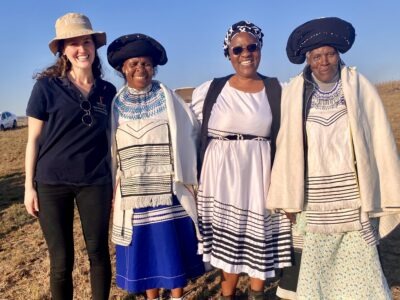At the beginning of each training that Farmer-to-Farmer (F2F) volunteer Josephine Hegarty led for the farmers of Senegal’s G.I.E. Millet producers group, she asked: “What have you done to solve the erosion problem?” The answer? Silence, because at the individual level, most farmers had done nothing.

Through NCBA CLUSA’s F2F program in Senegal, implemented in partnership with ACDI/VOCA and funded by USAID, Hegarty trained 89 farmers in six village meetings to observe, identify, and evaluate water erosion in culturally acceptable, sustainable, and purposeful ways. Her background in Peace Corps Senegal and use of the local Wolof language also helped her put the recommendations into useful terms, more applicable than broad natural resource management policies.
Natural Resource Management can be as far reaching as national forest and industry policies, and as personal as planting shrubs to manage erosion and promote soil fertility on local farms. Beyond the large-scale positive effects of environmental sustainability and the efficient use of resources, incorporating small natural resource management techniques such as using trees for wind shields or leaving weeds and crop stalks in the field help stem erosion. Such techniques can also increase the soil’s ability to absorb water, in turn improving fertility, and ultimately, increasing yields.
“The message that [the farmers] need to help themselves was an important idea that was conveyed,” said Hegarty. It was not just about erosion, but about the positive effects incorporating such techniques (planting trees and shrubs, ripping furrows perpendicular to the hillside, mulching) could have on their crops and their earnings. Farmers cultivated a sense of control over the widespread problem of erosion by learning from Hegarty small changes each could implement to combat erosion. They also developed a sense of how to work together as a group.
“We worked with Josephine for two days in the field. She explained to us why we should practice mulching during cropping time. The reasons given by the volunteer are so convincing that we will practice the recommendations for the next crop year,” said Rane Seck, chief of Safadi village, who attended an erosion prevention training. Getting village leaders on board helps convince others to implement these techniques for the upcoming season.
Because the next planting season will not come until next fall, convincing farmers to do whatever they can right now to combat soil erosion became a theme. “I was pleased when a younger farmer said he had planned on cutting out a tree in his field, but that after our talk he will leave it,” said Hegarty. Trees can act as wind barriers, protecting crops from storms. Their roots help the soil absorb water.
Understanding how important combating soil erosion was for their yields and their farms, some farmers have already gathered materials before the planting season. “We have already received stones and a wire fence from a partner and we will put a cord stone wall up as soon as possible,” said Ibrahima Dramé, a farmer from Koky Saloum village.
Small, easy-to-implement interventions such as mulching or leaving space at the end of the rip row can combat soil erosion. The more prepared farmers are for the upcoming planting season, the easier combatting erosion will be.







